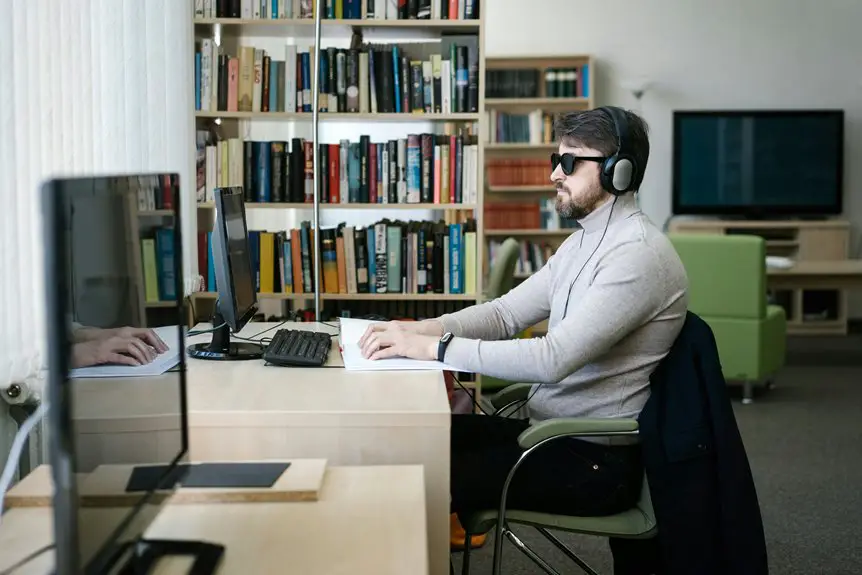Setting up your computer to reduce eye strain is crucial for your comfort and productivity. You'll want to start by adjusting your screen position and optimizing your lighting. These simple changes can make a significant difference. But there's more to consider, like monitor settings and regular breaks. Understanding these elements can transform your workspace. Let's explore how you can create an environment that supports your eyes effectively.
Table of Contents
Key Takeaways
- Position your monitor an arm's length away and at or slightly below eye level to minimize neck strain and enhance comfort.
- Optimize your workspace lighting by using soft, diffused light and minimizing glare from windows or bright lights on the screen.
- Adjust monitor settings for brightness, contrast, and color temperature to match room lighting and reduce eye strain.
- Follow the 20-20-20 rule by taking breaks every 20 minutes to look at something 20 feet away for at least 20 seconds.
- Use appropriate eyewear, such as blue light blocking lenses or updated prescriptions, to improve visual comfort during screen time.
Adjust Your Screen Position
To reduce eye strain, adjust your screen position for optimal comfort.
Position your monitor about an arm's length away from your eyes, roughly 20 to 30 inches. The top of the screen should be at or slightly below eye level, so you're looking slightly downward when viewing it. This angle minimizes neck strain and promotes better posture.
If you're using a laptop, consider using an external keyboard and stand to achieve this height. Make sure the screen's glare is minimized by tilting it or adjusting your seating position.
Regularly check your posture; keep your back straight and shoulders relaxed. These adjustments can make a significant difference in reducing discomfort during long hours of screen time.
Optimize Your Lighting
Proper lighting can significantly impact your comfort while working on the computer.
It's essential to create an environment that minimizes glare and reduces eye strain. Here are some tips to optimize your lighting:
- Use natural light: Position your workstation near a window to take advantage of daylight, but avoid direct sunlight on your screen.
- Adjust artificial lighting: Use soft, diffused lighting to illuminate your workspace. Desk lamps with adjustable brightness can help you find the right level.
- Eliminate glare: Position your monitor away from bright lights and windows to prevent reflections. Consider using an anti-glare screen protector if necessary.
Use the Right Monitor Settings
While you may not realize it, adjusting your monitor settings can make a significant difference in reducing eye strain. Start by tweaking the brightness to match your room's lighting. Too bright or too dim can cause discomfort. Next, adjust the contrast for better text visibility. Finally, consider changing the color temperature; warmer tones are easier on the eyes.
Here's a quick reference table to guide you:
| Setting | Recommended Value | Effect on Eyes |
|---|---|---|
| Brightness | Match room lighting | Reduces glare |
| Contrast | High (not maxed) | Enhances text clarity |
| Color Temperature | 5000K – 6500K | Warmer tones are softer |
These simple changes can create a more comfortable viewing experience.
Implement the 20-20-20 Rule
Even with the right monitor settings, prolonged screen time can still lead to eye strain. To combat this, you should implement the 20-20-20 rule. It's simple and effective: every 20 minutes, take a break and look at something 20 feet away for at least 20 seconds. This quick reset helps your eyes relax and refocus.
Here's how to make it easier:
- Set a timer on your phone or computer to remind you.
- Use breaks to stretch and move around, which benefits your overall health.
- Keep a designated spot 20 feet away to focus on, like a window or a picture.
Following the 20-20-20 rule will significantly reduce eye strain during your screen time.
Choose the Right Glasses
How can the right pair of glasses make a difference in reducing eye strain? Well, they're essential for optimizing your vision during long hours at the computer.
If you spend a lot of time on screens, consider getting blue light blocking lenses. These lenses filter harmful blue light emitted by digital devices, which can lead to discomfort and fatigue.
Additionally, ensure your prescription is up to date; outdated prescriptions can strain your eyes unnecessarily. If you wear bifocals or progressives, opt for computer-specific lenses that provide a wider field of view for screen distance.
Don't forget to try on different frames to find the most comfortable fit. With the right glasses, you'll notice a significant improvement in your eye comfort.
Maintain a Comfortable Distance
Maintaining a comfortable distance from your computer screen is crucial for reducing eye strain. Ideally, your screen should be about an arm's length away, which typically ranges from 20 to 30 inches. This distance allows your eyes to focus without excessive effort.
Here are some tips to help you find the right spot:
- Adjust your chair height: Ensure your feet are flat on the floor and your knees are level with your hips.
- Tilt your screen: Position the top of your monitor at or just below eye level, so you're looking slightly downward.
- Use a ruler: If you're unsure about the distance, a simple ruler can help you measure the ideal spacing.
Take Regular Breaks
Taking regular breaks is essential for preventing eye strain, especially during long hours in front of a screen. Incorporate the 20-20-20 rule: every 20 minutes, look at something 20 feet away for at least 20 seconds. This simple practice helps your eyes relax and refocus.
| Break Type | Duration | Activity |
|---|---|---|
| Short Break | 5 minutes | Stand up, stretch |
| Eye Exercise | 1 minute | Blink rapidly |
| Longer Break | 15-30 minutes | Take a walk outside |
Frequently Asked Questions
What Are the Symptoms of Eye Strain?
When you experience eye strain, you might notice symptoms like headaches, blurred vision, dry eyes, or difficulty focusing. You could also feel tiredness in your eyes or discomfort after prolonged screen time.
How Often Should I Use the 20-20-20 Rule?
You should practice the 20-20-20 rule every 20 minutes. Look at something 20 feet away for at least 20 seconds. It helps reduce fatigue, keeping your eyes comfortable and focused throughout your screen time.
Can Blue Light Filters Really Help?
Yes, blue light filters can help reduce eye strain by blocking harmful blue light emitted from screens. They're especially useful during prolonged use, making your screen time more comfortable and potentially improving your sleep quality at night.
How Do I Know if My Monitor Is Too Bright?
You can tell your monitor's too bright if your eyes feel strained, you see glare, or you squint often. Adjust brightness settings gradually until the screen feels comfortable and easy to read without discomfort.
Are There Specific Exercises to Relieve Eye Strain?
Yes, there are exercises to relieve eye strain. Try the 20-20-20 rule: every 20 minutes, look at something 20 feet away for 20 seconds. You can also blink frequently to keep your eyes moist.




